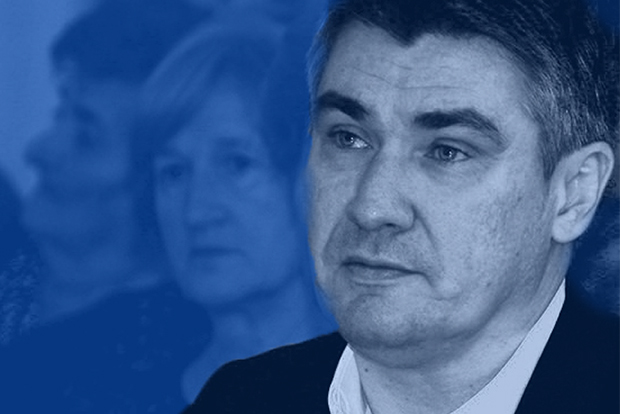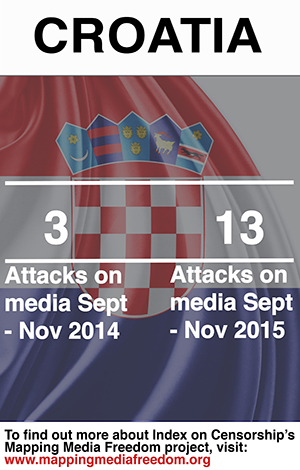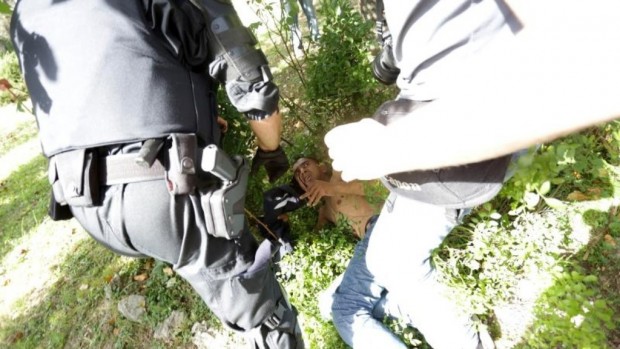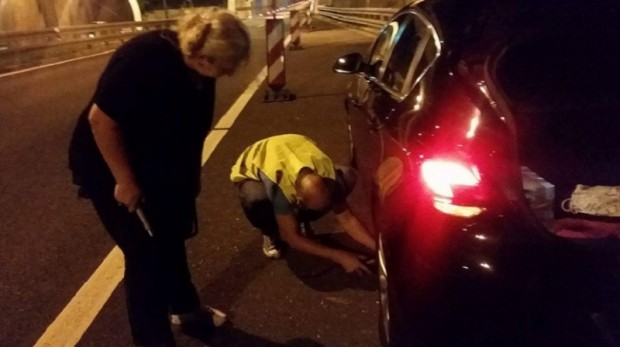20 Nov 2015 | Croatia, Europe and Central Asia, mobile, News

Croatian prime minister Zoran Milanović. Original image by SDP Hrvatske
A worrying escalation of attacks on the media in Croatia has been recorded by the Index’s Mapping Media Freedom project in the last three months. Since 1 September there have been 13 attacks, compared with 3 in the same period last year.
In August, we reported an increase in media violations in Croatia. Deaths, physical assaults and intimidation had been plaguing the Croatian media for months. Increasing violence is still undermining media freedom in Croatia.
Hannah Machlin, Index’s Mapping Media Freedom project officer, said: “The increasing amount of violence against Croatian journalists is quite alarming. In reaction to the migrant crisis, there’s been a particularly high number of cases on the Hungarian/Croatia border.”
The Croatian constitution guarantees freedom of expression and the press, and “these rights are generally respected in practice”. Freedom House does, however, acknowledge that journalists face political pressure, intimidation and the “occasional” attack. According to Freedom House, Croatia has been a “free” country for some years.
Below, Index on Censorship details some of the worst cases from Croatia since September.

Overall attacks, including violence, intimidation, loss of employment and censorship of work
1. Media workers assaulted by police at Serbian border
In early October, Croatia opened its border with Serbia, easing one of the main areas for congestion for refugees trying to make their way north. On 19 October, Mapping Media Freedom recorded that media workers were harassed and assaulted by Croatian police on the border near the Bapska-Berkasovo crossing. Regional N1 television reported that the Croatian police had also confiscated the journalists’ equipment.
“When they moved against me, I shouted that I was an AFP photojournalist and that their colleagues had checked my ID this morning,” Andreja Isakovic told N1. “They asked me to hand over the cards. One of them ran towards me, caught up with me and threw me into the mud. They took away my cameras in a savage manner and threw them into an orchard on the Croatian side, so I could not reach them. They did the same to my colleague from England.”
2. Greek journalists attacked by masked assailants
In mid-October, two Greek journalists, George Stasinopoulos and Dionisis Verveles, were attacked by unidentified individuals while walking near a sporting event in Zagreb. Two men wearing face masks stopped the journalists on a street, asking them to identify themselves and their origin. When the two colleagues attempted to run away, they were attacked.
One journalist was beaten and the other was threatened by one of the assailants who was brandishing a knife. When the journalists began shouting that they were members of the press, the attackers fled the scene.
3. Prime minister’s father threatens journalist
Velimir Bujanec, host of the controversial TV show Bujica, was verbally assaulted by Stipe Milanović, father of Croatian prime minister, Zoran Milanović. Gordan Malic, a local freelance investigative journalist based in Croatia, was also threatened. Around noon on 3 October in a coffee bar in the center of Zagreb, Stipe Milanović allegedly said that “Bujanec and Gordan Malic should be beaten up”. There were three witnesses to his comment.
Bujanec reported to the media and posted it on Facebook. After speaking with his lawyer, he also reported the incident to the police and is now reportedly pressing charges against Milanović for verbal assaults and threats.
4. Journalist’s car tires slashed
Suzana Trninic is a journalist with the Serbian television broadcaster B92. On 24 September, while travelling to a media festival in Rovinj with Belgrade license plates on her car, she and her team stopped for coffee at a petrol station in Grobnik. When they returned, one of the car’s tires had been slashed.
There was visible sticker press on the vehicle, Trninic said. She did not want to report the incident to the police and media on the day as she did not want to distract from the ongoing border crisis between Serbia and Croatia.
Trninic believes the incident is connected with her being a Serbian journalist.
5. Asylum seeker attacks TV crew

“I’ll kill you!” yelled the assailant as a stone hit the cameraman. Click image for video. Credit: Večernji.hr
On Thursday 17 September 2015, an asylum seeker from Kosovo began shouting threats and then threw a brick at the TV Mreza crew reporting at Hotel Porin. One cameraman was injured. The assailant was immediately restrained by other journalists until riot police arrived and detained him.
Hotel Porin is both a reception and registration centre where asylum applications are completed, including fingerprinting and medical examinations. As Croatian media has reported, almost all refugees are polite and grateful and all have the right to leave the hotel and walk around Dugavama.
Details of attacks on the media across Europe can be found at Index on Censorship’s Mapping Media Freedom website. Reports to the map are crowdsourced and then fact-checked by the Index team.
Mapping Media Freedom
Click on the bubbles to view reports or double-click to zoom in on specific regions. The full site can be accessed at https://mappingmediafreedom.org/
|
20 Nov 2015 | Europe and Central Asia, Mapping Media Freedom, mobile, News, Russia
The Russian Ministry of Justice has added Glasnost Defence Foundation (GDF) to the list of NGOs it considers foreign agents. The decision was made after an “unplanned inspection”, Radio Liberty reports.
GDF, founded in 1991, is one of Russia’s oldest human rights organisations protecting freedom of the media. It provides Russian journalists with legal information and support. It also monitors media freedom abuses. GDF is the founder of the Andrey Sakharov journalist prize, Journalism As A Deed. The organisation has been headed by a well-known human rights defender, filmmaker and critic, Alexei Simonov.
GDF is not the first Russian journalist and media NGO unwillingly recognised as a foreign agent. At the beginning of 2015, another media freedom NGO, the Centre For The Protection Of Media Rights, was added to the list. In October 2015, Sobytie, a photoclub, became the 100th organisation on the list of foreign agents.
Mapping Media Freedom
Click on the bubbles to view reports or double-click to zoom in on specific regions. The full site can be accessed at https://mappingmediafreedom.org/
|
20 Oct 2015 | Europe and Central Asia, Mapping Media Freedom, mobile, News, Russia

On 6 November 2010, prominent Russian journalist Oleg Kashin was badly beaten with a steel pipe on his doorstep and nearly killed. He suffered a broken skull and injuries to his legs and hands — including broken fingers and one amputated digit. He was hospitalised in a coma and spent months recovering. Dmitry Medvedev, who was then President of Russia, visited him promising that the case would be solved and the attackers would be punished.
At the time, Kashin’s editor told the BBC that the attack was retribution for articles he had written and that he had recently reported on anti-Kremlin protests and extremist rallies.
Two months prior to the assault, Kashin had had an online quarrel with Andrey Turchak, the powerful governor of the Pskov region. According to the police investigation into the attack, the alleged organiser Alexander Gorbunov paid 3.3 million roubles ($53,000) to ex-employees of the security department of Zaslon, a company owned by Turchak’s family, to beat Kashin. Later the wife of Danila Veselov, one of the defendants, gave an interview to the Kommersant newspaper, claiming that her husband had met Turchak before the attack and had recorded the governor saying that Kashin had to be beaten so he “could not write anymore”.
After five years of investigation, in September 2015, Kashin publicly named the men who were officially accused of attempted murder. Despite evidence of the possible involvement of Turchak, who is a son of a friend of Putin, he has not been questioned about the attack.
On 3 October, Kashin posted A Letter to the Leaders of the Russian Federation on his blog. In it, Kashin wrote about his frustrations, saying: “Your will in Russia is stronger than any law, and simply obeying the law is an impossible fantasy.” The open letter accuses the government of hindering the investigation into his violent assault and ends as a strong indictment of the whole political system in Russia.
Moreover, the investigator who arrested the attackers was suspended from the case. His successor was quoted in Kashin’s letter saying: “There’s the law, but there’s also the man in charge, and the will of the boss is always stronger than any law.”
In his letter, Kashin directly accused the leaders of the country of protecting Turchak from any judicial responsibility.
“You’ve decided to side with your Governor Turchak; you’re protecting him and his gang of thugs and murderers. It would make sense for somebody like me — a victim of this gang — to be outraged about all this and tell you that it’s dishonest and unjust, but I understand that such words would only make you laugh. You have complete and absolute control over the adoption and implementation of laws in Russia, and yet you still live like criminals.”
Kashin admitted that he does not expect a fair punishment for the alleged mastermind of his beating: “I can see perfectly well that the worst thing Turchak faces now is a quiet resignation, timed long after any developments in my case. This is the only justice citizens can expect, and it means that your system isn’t capable of any kind of justice at all.”
Kashin’s case has become the symbol of impunity for attacks and murders of journalists. Hundreds of leading Russian journalists signed a petition that demands the police question Turchak. Some of them publicly boycotted a literature festival in the Pskov region, while the Kremlin and the Gorbunov’s press office remained silent.
Kashin said he wishes all journalists would boycott Turchak and continue to send requests about his role in Kashin’s case to government officials. However, that level of solidarity seems to be impossible when so much of the media is directly run by the Kremlin and do not dare to do anything without its approval, said Kashin. He also holds out no hope for support from the Russian Union of Journalists, which he describes as “a weird organization” that doesn’t function properly.
According to Glasnost Defence Foundation, over 150 journalists were killed in Russia in last 15 years. The majority of these cases remain unsolved. Those who are accused of obstruction of professional activities of journalists, rarely face a fair punishment. Between 2006-2014, only one such defendant was sentenced to jail.
The murder of Igor Domnikov, a journalist with Novaya Gazeta, in 2000 has become the first case in the history of modern Russia where the mastermind behind the killing of a journalist was officially accused. In this case, it was a former Vice-Governor of Lipetsk region Sergey Dobrovskiy. After 15 years of investigations, he was summoned to a court in April 2015, but a month later the case against him was dropped due to the statute of limitations.
Kashin said he will not be surprised if his case goes the same way. However, he stressed that the difference is that the investigators don’t need 10 years more as there is already evidence.
“We can see that the government is just not interested in punishing criminals,” Kashin said.
Mapping Media Freedom
Click on the bubbles to view reports or double-click to zoom in on specific regions. The full site can be accessed at https://mappingmediafreedom.org/
|
15 Oct 2015 | Europe and Central Asia, Macedonia, Mapping Media Freedom, mobile, News

The successor nations to the former Yugoslavia are among the most difficult places for journalists to work in Europe, a fact borne out by the latest quarterly report from Index on Censorship’s Mapping Media Freedom project. In the case of Macedonia there have been 35 verified incidents since the project began in May 2014.
Journalists have been subjected to verbal threats, online trolling, intimidation and physical assaults against their person and property. But another issue afflicting Macedonia’s 200 media outlets is more insidious: government advertising budgets of €30-40 million that warp the market and act as a constraint on media outlets and journalists alike.
“The outlets compete in a small, distorted market, covering around 2 million citizens, where they cannot survive financially unless they align their interests with the governing parties and politically-connected large businesses,” according to November 2014 report from the Association of Journalists of Macedonia (ZNM) report.
Since 2009, when the European Commission Progress Report first criticised the use of government advertising as a tool “to undermine editorial independence”, media freedom in Macedonia has become more openly discussed.
According to a report published by the government, between 2012 and the end of the first quarter of 2014, ruling parties spent about €18 million on 27 government media campaigns. It spent €6.6 million in 2012, €7.2 million in 2013 and almost €4 million in the first six months of 2014. To date, the report was the only time that the government released information about public money spent on promotional or awareness-raising advertisements.
Most government-funded advertisements are aimed at informing citizens about the benefits of reforms, encouraging innovation and entrepreneurialism and promoting family values. In a statement on state ads, ZNM said: “Government campaigns have nothing to do with the public interest and are pure political propaganda of the government paid by public funds.”
“The government claims that campaigns are implemented in order to inform citizens about the importance and significance of specific policies and measures,” ZNM wrote. In effect, the organisation said, Macedonia’s government uses taxpayer money to tell citizens that its efforts have been successful, whether or not the reforms have actually succeeded.
After criticism from Brussels, the Macedonian government temporarily halted state-funded campaigns, and, as Balkan Insight reported, this will last “until the authorities agree on tighter rules for spending public funds on ads”. Unpaid public service announcements were not affected by the order.
The 2014 annual report examining the broadcast market from the Macedonian Agency for Audio and Audiovisual Media Services did not include a breakdown on government advertising spending, a departure from previous years. The 2012 report showed that the government had been the largest single source of ad budgets, outpacing telecommunication firms, Proctor & Gamble and Coca Cola. The government slipped to become the second largest advertiser, according to the .
A study conducted by ZNM examined the €18 million spent on advertising by the government since 2012. According to the report, the largest slice of the advertising buys were directed to pro-government media outlets “creating even more robust political-clientelistic and corrupt links between the government and the media”.
Another organisation, Media Integrity Matters, found that the government’s role in the advertising marketplace was deleterious. “These phenomena have prevented the media from performing their basic democratic role – to serve the public interest and citizens” the organisation wrote in its report, which recommended that media finances be transparent and monitored by independent bodies.
Mapping Media Freedom
Click on the bubbles to view reports or double-click to zoom in on specific regions. The full site can be accessed at https://mappingmediafreedom.org/
|






